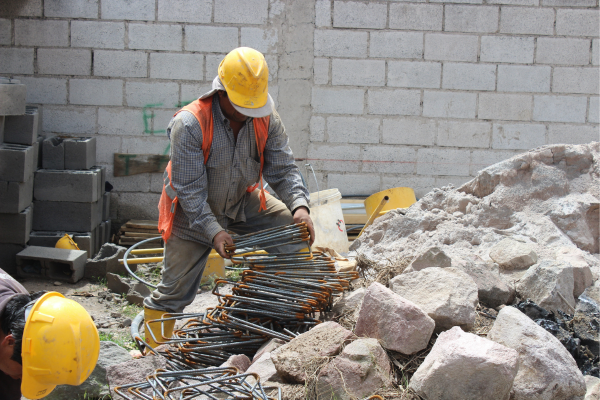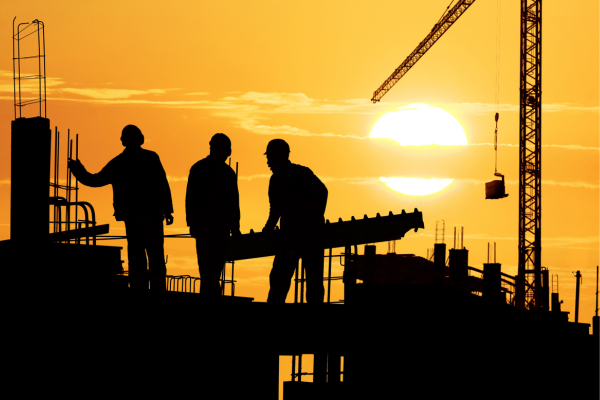.png)
Blueprints for Waste-Free AEC
Imagine strolling through a bustling construction site. The sounds of hammers, the scent of freshly cut wood, the sight of workers bustling around, laying the foundation for what will soon become a stunning structure. Amidst this hive of activity, there's a silent concern growing — heaps of discarded materials, offcuts, and debris. It's a sight that's unfortunately too common, reflecting a challenge that the AEC (Architecture, Engineering, Construction) industry grapples with: construction waste. With the mounting pressures of environmental sustainability, professionals are looking for practical solutions. Join me as we delve into the world of construction waste and explore the sustainable strategies that today's AEC professionals can adopt to make a lasting difference.
Understanding the Scope of the Issue
When we think of pollution, images of smokestacks or plastic-filled oceans often come to mind. Yet, hidden in the shadows of towering skyscrapers and cozy homes lies a challenge just as pressing. Construction sites, for all their promise of new beginnings, churn out a staggering amount of waste. From unused bricks to scrap metal, from misshaped wood pieces to excess cement, the remnants of a building can accumulate quickly. And it's not just about the physical clutter. This waste can have harmful effects on our environment and can weigh heavily on project budgets.
The numbers tell a tale of their own. Recent studies indicate that the construction sector is one of the largest waste producers, with a notable percentage ending up in landfills. This isn't just a tiny concern or an occasional hiccup. It's a consistent, industry-wide issue beckoning for attention and action. As we peer into the vast construction landscape, it becomes vital to grasp the depth of this waste issue. Only then can we start laying the groundwork for sustainable solutions.
Environmental Impact of Construction Waste
When you stand on a bustling construction site, it's easy to be swept up by the marvel of human creation. Tall cranes stretching to the sky, the rhythm of hammers, and the promise of new beginnings. But amidst all this, there's a hidden story - one that nature silently witnesses. This tale is about the environmental impact of construction waste.
Picture the countless tons of discarded materials: wood, metal, glass, and more. Left unmanaged, these heaps continue. They find their way to landfills, occupying precious land. Over time, some materials break down and release harmful chemicals into the soil, potentially contaminating groundwater sources we rely on.
Then there's the issue of resource extraction. Every wasted brick or unused metal beam signifies resources pulled from the earth unnecessarily. This means more deforestation, mining, and a more significant strain on our planet's natural reserves.
It's also worth noting the energy factor. The production of many construction materials consumes vast amounts of energy, leading to greenhouse gas emissions. When these materials are wasted, we're throwing away physical resources and the energy and effort invested in them.
In the heart of a city or the outskirts of a small town, every construction project leaves its mark on the environment. As professionals in the AEC world, recognizing and understanding this footprint is the first step toward a path of responsibility and mindful building. Because, after all, the world we build in is what we call home.
Sourcing Sustainable Materials
Imagine standing in a freshly built room, the walls echoing the hum of recent activity. Now, think about the materials that give life to that space:
-The sturdy wood framing the window
-The smooth touch of the stone countertop
-The gentle curve of the metal doorknob
Each element has a story, a journey from the earth to the tower. And as professionals, we have the choice to shape that story. One of the most impactful choices? Opting for sustainable materials.
Sustainable materials aren't just a buzzword or a fleeting trend. It's a call to action. It's about choosing resources harvested responsibly without depleting them for future generations. Think of wood from responsibly managed forests or stones sourced from ethical mines.
Beyond the ethical angle, there's a practical side. Sustainable materials often come with an added layer of quality. They're made with care, built to last, and designed with both beauty and longevity in mind. This means less frequent replacements and, consequently, less waste in the long run.
Additionally, sourcing close to home can make a difference. Local materials reduce the carbon footprint tied to transportation and support nearby communities and economies. It's a win-win for the environment and the local scene.
Switching to sustainable materials is about more than just feeling good or checking a box. It's an investment in the future—of our projects, our reputation, and our planet. And every time we make that choice, we're sending a message, brick by brick and beam by beam, that we're in the business of building responsibly
Embracing the Concept of a Circular Economy
There's a certain beauty in giving things a second chance. Think about that old chair you refurbished or the worn-out jeans you turned into trendy shorts. This idea of reusing, revamping, and recycling is at the heart of the circular economy. Instead of the old "take, make, dispose" approach, we're shifting to a more thoughtful cycle.
In the AEC industry, this means looking at construction materials and waste in a fresh light. Rather than tossing out offcuts or excess materials, the focus shifts towards finding ways to bring them back into the building process. It's like a revolving door for materials; everything gets a new lease on life.
This isn't just a trendy buzzword; it's a change in mindset. By seeing value in what was once deemed waste, the industry can reduce its environmental footprint and save a pretty penny. So, the next time we see a pile of discarded materials, we should ask: "How can we bring these back into the fold?" That's the essence of a circular economy.
Adopting New Technologies and Techniques
In an age where technology transforms our daily lives, from how we order our coffee to how we communicate, it's no surprise it's also reshaping the AEC world. And when it comes to addressing construction waste, innovation is at the forefront of sustainable change.
Imagine a construction site where precision tools and software ensure materials are cut just right, minimizing offcuts. Picture a world where advanced scanning tools assess a place before construction begins, helping teams anticipate and reduce waste. These aren't scenes from a futuristic movie; they're happening now.
But it's not just about flashy gadgets. It's also about smart techniques. Simple strategies, like better planning, optimizing material orders to fit specific project needs, and learning from past projects, can significantly dent waste production.
As AEC professionals, embracing these new tools and approaches is about more than just being trendy. It's about paving the way for a more sustainable future where buildings rise and waste falls.
Fostering Collaboration and Education
Imagine a construction site as a symphony. Each worker, from the bricklayer to the electrician, plays a crucial part, and the harmony they create together determines the final masterpiece. However, the music could quickly become discordant without communication, understanding, and coordination. The same applies when we're tackling the issue of construction waste.
It's a shared responsibility, and every hand on deck needs to be in the loop. That's where collaboration comes into play. Teams need to work together, sharing insights on minimizing waste, optimizing resources, and implementing sustainable practices. This teamwork extends beyond just the construction crew. Architects, suppliers, and clients can join the conversation, adding unique perspectives and solutions.
Yet, collaboration isn't just about talking; it's also about learning. This means creating education opportunities. Workshops on sustainable building practices, seminars on new waste-reducing technologies, or informal team discussions can illuminate the path forward.
As we come together, sharing and learning, we're not just constructing buildings but building a brighter, waste-free future for the AEC industry.
The Ripple Effects of Waste Reduction
Sometimes, it's easy to forget that our actions have consequences beyond our immediate surroundings. Think of tossing a pebble into a pond. The splash might be small, but the ripples spread wide. The same holds true for waste reduction in the AEC industry. On the surface, it might seem like we're just addressing a pile of discarded materials, but the impact is much more profound and broader.
Reducing construction waste doesn't just free up landfill space. It leads to cost savings, as buying only what's necessary and repurposing leftovers keeps budgets in check. Beyond the dollars and cents, there's an environmental win. Less waste means fewer resources extracted from our already strained planet, and that's a big plus for Mother Nature.
But here's the heart: when the AEC industry champions waste reduction, it sends a message. It tells communities that sustainability matters and that we care about the world we're building for future generations. And in return, this can inspire homeowners, businesses, and other industries to follow suit.
In the grand scheme, addressing construction waste is like that small pebble. The act might seem minor, but the positive ripples it creates are vast and far-reaching. And that, dear reader, is the beauty of making a change.
Wrapping It Up
Stepping back and looking at the bigger picture, it becomes clear: our industry has the power, the tools, and the responsibility to lead the charge against construction waste. It's more than just managing leftover materials; it's about reshaping the narrative of how we build and create. It's about setting standards that prioritize not just efficiency but also sustainability.
Tackling construction waste, though challenging, brings us face-to-face with numerous rewards. The advantages are plentiful, from economic benefits to a healthier environment and a more substantial community reputation. And as we journey forward, let's remember that every brick laid thoughtfully, every beam placed with precision, and every project approached with sustainability in mind builds a legacy for a brighter, greener tomorrow.
Here's to building structures and a future filled with hope and purpose.
Turn Estimations into Certainties – With BidLight by your side, why guess when you can know?
Click to explore 👉 www.bidlight.com


